#John... president Coin....
Text
In theory the divulging of GTN as lesbian necromancers in space is enticing, but they should've hooked the Hunger Games in their marketing as they tend to.
From the shitty post-apocalyptic world, living in the shittiest part of the society where everyone is dying around you, being simultaneously the least and most capable people in this "competition", shady alliances, loss of innocence, the feeling of helplessness in failing to protect those weaker than you, some fucked up character is coughing up blood, dealing with adults (yuck), realizing the plot is much thicker than you first imagined, dealing with survivor's guilt, etc, etc... except you're in Peeta's head and he's funny and strong and also a badass girl and Katniss is a goth necromancer.
(Gross generalizations were used in the making of this post.)
#i could even draw an effie haymitch and mercy augustine parallel but I won't#but.....#John... president Coin....#i mean#AND I WANT TO MAKE IT CLEAR THIS IS ALL IN POSITIVE LIGHT#i *love* both series#of course gtn is very innovative in its world building and characters but as general trops#i think it would've been a reasonable marketing strategy#the locked tomb#gtn spoilers
8 notes
·
View notes
Text
my views on trump as an outsider
#fuck trump#donald john trump#trump coins#president trump#trump is a threat to democracy#gop#fbi#raid#donald trump#impeachment#jo biden#north amarica#usa
1 note
·
View note
Text
Trump sues the justice department
Former US President Donald Trump has asked a judge to freeze the justice department's investigation regarding the sizing of files from his Mar-a-Lago residence.
In this lawsuit, Trump's legal team has requested that an independent lawyer must be appointed to oversee the documents that the FBI agents seized a few days ago.
On the 8th of August, eleven sets of classified files were taken from his residence; Mr. Trump is being investigated for allegedly mishandling the documents.
Read more
#trump news#donald john trump#trump#politics#republicans#president trump#trump coins#trump2024#trump 2022
0 notes
Text
Toss a coin for John Paul Jones
John Paul Jones has been lauded as the father of the US Navy since 1775. His influence and leadership were fundamental to the founding of our Navy and in many ways to the success of the American War of Independence.

The tomb of John Paul Jones in the U.S. Naval Academy Chapel's crypt, Annapolis, Maryland
The remains of John Paul Jones were interred in 1906 in a ceremony presided over by President Theodore Roosevelt in the crypt beneath the Naval Academy crypt. Since his death in 1792, John Paul Jones' remains had lain in a grave in France, where he also died.
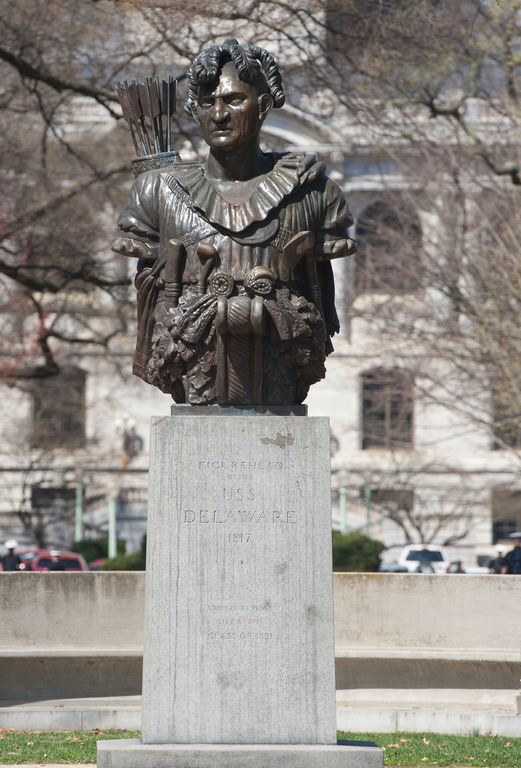
The Tamanend Figurehead of the USS Delaware, 1817
Now, since 1906, it has been the custom of the Midshipmen of the Academy to deposit coins at his grave to ask and thank him for help in examinations and a successful graduation as well as a successful career. Another helper on campus is the statue of Tamanend, a peaceful Delaware chief of the Lenape Nation, to whom coins are also offered to request his help in examinations.
#naval history#sailors superstition#american midshipmen#midshipman monday#age of steam#early 20th century
90 notes
·
View notes
Text
Folklore in Fargo
Spoilers ahead, Sailor.
One of the things I loved about Fargo this season so far, is the incorporation of Folklore, suberstition and God.
We meet Ole Munch (Sam Spurrell) in the first episode. He seems to be a regular hitman of sorts, who is set on Dorothy (Juno Temple) He comes across a bit excentric and the way he talks and dresses seem very anachronistic.
We also learn, that Dot is not the regular homemaker and loving mum, she seems to be. Munch and his handyman set out to kidnap Dot.
Munch and his handyman aren't able to capture her and the handyman was killed in the process.
We get to know Roy Tillman (John Hamm) who was the one who sent Munch on his mission, but because he failed the task, Roy is not paying Munch, which sets off a rather bleak storyline in which Roy and his son Gator (Joe Keery, my love) try to kill him. He escapes!
The most intriguing thing about Ole Munch is one, the ritual he performs at the Tillman Farm. He kills a goat, covers himself in it's blood and leaves a message for Roy over his Daughter's beds.
And two, the flashback to Wales in 1522.
See now, this is where it gets weird. And where I had to google some stuff.

We see a character, dressed in what seems to be clothes of the lower class, entering a house full of upper class people who are in mourning, dressed in black and weaping. We have a funeral on our hands here. The poor person looks like Ole Munch. Is it him? Is it an ancestor of his? We dont know.
On the belly of the deseiced is a plate with food.
When Munch enters the house, there is a tense energy in the room.
Munch walks up to the dead body and consumes the food offered on the plate in an almos animalistic fashion. The people in the room gasp, some of them disgusted, some of them afraid. Or both.
Before Munch leaves, he gets two silver coins. Which must have been a lot of money back in the day, I did not research that.
But we clearly witnessed some sort of ritual happening.
It turns out, sin eating was a practice rich people took part of in Wales, Ireland and England in the 1600s. A willing poor person was invited to literally eat the sins of the deseaced person, so they could be welcomed at the pearly gates, with a clean record.
All the sins are transferred, to the person who ate the food. A grewsome fate for people at the time, but hey, a mans gotta eat.
The world is bleak, so I don't go with the rational reason in fiction, ever. I like to think that Ole Munch ate so many sins, that he became a spirit, that can not die, who is forced to wander around the earth forever, and for some reason chose america. His very beautifully written monologues would suggest that. They almost sound shakespearian.

But how does this play into the bigger theme of Fargo S5?
Well, if you think about it, the whole season is about unpaid depts and consequences. Dot ran away from Roy and the farm, because of domestic violence. In Roy's book, she owes him, because she made a pledge to him, when they got married.
Ole Munch sees a debt not paid, because he didn't receive paymant for "eating the sin" of kidnapping Dot.
Dot's husband's mother, who is a very rich lady played by the brilliant Jennifer Jason Leigh points out "What is the point of being a billionaire, if you can't get someone killed.", while on the phone with an ex-president, apparently Bill Clinton, if I remember right.
It's like, we never got over the sin eating, because with money and power, you can pay your way out of any circumstance, be it kidnapping or murder. There is always going to be someone who needs the money more than their soul. And there is always going to be someone who takes advantage of that.
Roy Tillma, quotes the bible a lot. He thinks of himself as a right and just man and leader, even though he likes to bend the law to his will. He does not give a flying fuck about the law as it is "dictated by washington" and funds a right wing militia with taxpayer money. He is the law of the land. These scenes sent shivers down my spine.
Anyway. All of the storylines in this show are so amazing and worth writing about. Go watch it, you won't regret a second.
#fargo#fargo season 5 spoilers#fargo s5#dot lyon#gator tillman#joe keery#blocksberg writes#fargo fx#john hamm#juno temple#fargo spoilers#ole munch#sin eating
51 notes
·
View notes
Text

The Great Binge: The Drug-Fuelled “Belle Epoque”
The Belle Époque or La Belle Époque; French for "Beautiful Epoch" is a period of history, usually considered to begin around 1871–1880 and to end with the outbreak of World War I in 1914. It was a period characterized by optimism, peace, economic prosperity, colonial expansion, and technological, scientific, and cultural innovations. In this era of France's cultural and artistic climate (particularly within Paris), the arts markedly flourished, and numerous masterpieces of literature, music, theatre, and visual art gained extensive recognition.

The Bar At Maxim's, Vintage Artwork By Pierre-Victor Galland
The Great Binge refers to the same period spanning 1870 to 1914 in North America. It was coined by modern historian Gradus Protus van der Belt to describe a time when drugs like cocaine, heroin, opium, absinthe, laudanum, and many more were freely available not just from your local pharmacy, tobaconists or the neighbourhood bar, but also from the barbershop, the stationers, and even confectioners.

Morphine by Albert Matignon - 1905

Georges Moreau de Tours - Les Morphinees The Morphine Takers - 1886
Between 1827 and 1842, over 27,000 pounds of opium came into the ports of the United States alone, where the drug found an unexpected distribution network of businessmen, presidential parents, and even Ivy League schools, which all had ties to the Opium trade in the late 19th century.

The Illustrated London News print of the clipper steamship Ly-ee-moon, built for the opium trade, c. 1859
“Princeton’s first large benefactor, John Green, funded his contribution through the opium trade […] Yale University’s infamous Skull and Bone society was funded by the most successful family of opium dealers in America,” reveals Harvard’s magazine, The Crimson, adding that as America’s gateway institution for the drug that soon spread to other Ivy Leagues along the East Coast, “Opium once pervaded campus life at Harvard […] throughout the 1800s, its black smoke kept the university’s veins flowing with green and its faculty and students perpetually dazed.”

The term “pipe dream” actually originates from the opium dens of turn of the century America where people smoking an opium pipe would come up with ideas, theories and fantasies whilst hallucinating.

In 1908, President Roosevelt appointed Hamilton Wright as the first Opium Commissioner in the United States to begin targeting opium dealers. The irony here is that Franklin D. Roosevelt’s grandfather, Warren Delano, was an opium peddler, and his drug trade was responsible for the bulk of the family’s fortune. Roosevelt’s mother, Sara Delano, travelled to Hong Kong with her family to join her opium-trading father in the 1860s.
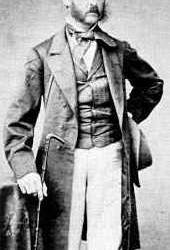
Warren Delano (FDR's grandfather & Opium King)

Sara (FDR's mother) & Philippe Delano in 1864, following their return home from Hong Kong. (Franklin Roosevelt Library)
The crackdown on the Great Binge inevitably began with the signing of the 1912 International Opium Convention to suppress opium smoking and to limit it to medicinal purposes. In the 1920s, in the US, an anti-drug crusade also saw heroin cough drops and cocaine tablets to slowly disappear from stores and bathroom cabinets.
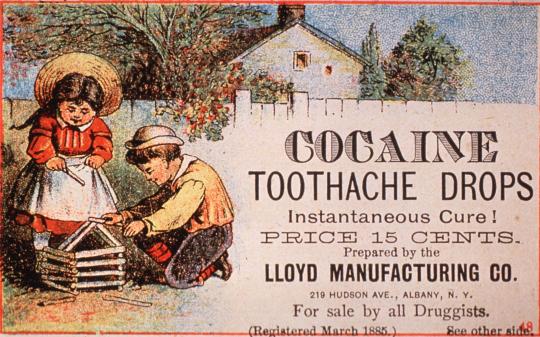
In the 1920s, in the US, an anti-drug crusade also saw heroin cough drops and cocaine tablets to slowly disappear from stores and bathroom cabinets.
During the Great Binge, the most notable drink in circulation was the Vin Mariani, an alcoholic beverage that combined both wine and cocaine.

Angelo Mariani, a French chemist who invented a very popular beverage in 1863.
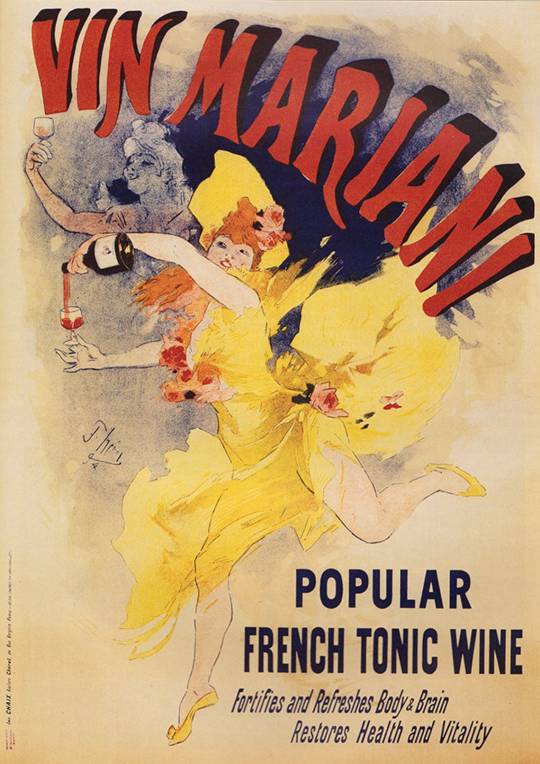
Mariani tonic Wine — lithography by Jules Cheret
The French "Tonic" Wine received endorsements from Pope Leo XIII as well as many of the Belle Epoque’s most famous names, Sarah Bernhardt, Jules Verne and even Queen Victoria were all fans of the drug-infused cocktail.

Pope Leo XIII even allowed his face to be used in Vin Mariani’s marketing campaign. He was very much a brand ambassador, citing that it strengthened him “when prayer was insufficient”.
Mariani's "Tonic" would spent the following century cleaning up its act & rebranding itself to become the world’s most iconic household brand: Coca Cola
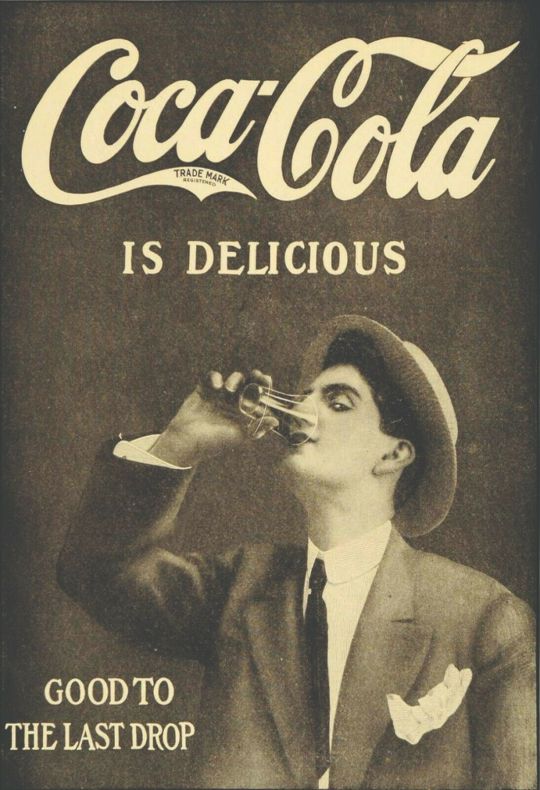
#belle epoque#Beautiful Epoch#paris#Great Binge#cocaine#opium#Morphine#Albert Matignon#Les Morphinees#Georges Moreau de Tours#ivy league schools#Ivy League#Opium trade#princeton#yale#harvard#pipe dream#franklin d. roosevelt#fdr#Warren Delano#Sara Delano#Angelo Mariani#Vin Mariani#Pope Leo XIII#jules verne#queen victoria#coca cola
69 notes
·
View notes
Text
ides of march

well, its tumblr's favorite holiday and who can blame us? The assassination of Julius Caesar is probably one of the only group projects that ever went down the way it was supposed to with, well, not complete group participation (there were said to be upward of 60 people involved but only 23 stab wounds - obviously someone was not carrying their weight) but at least a good effort was made at it. But lets take a moment, between our jokes about salad and Animal Crossing butterfly nets to look at what else has happened in history on the Ides of March. For instance, did you know, on March 15th:
1493 - Columbus returned to Spain after 'discovering' the new world.
1580 - Phillip II of Spain put a bounty on the head of Prince William I of Orange for 25,000 gold coins for leading the Dutch revolt against the Spanish Hamburgs
1744 - King Louis XV of France declares war on Britain
1767 - Andrew Jackson, who would go on to be the seventh president of the US, was born.
1820 - Maine became the 23rd state in the US
1864 - the Red River Campaign, called 'One damn blunder from beginning to end' started for the Union Forces in the American Civil War
1889 - a typhoon in Apia Harbor, Samoa sinks 6 US and German warships, killing 200
1917 - Czar Nicholas II abdicated the Russian throne, bringing an end to the Romanov dynasty
1955 - the first self-guided missile is introduced by the US Air Force
1965 - TGI Friday's opens its first restaurant in New York City
1991 - in LA, four police officers are brought up on charges for the beating of Rodney King
2018 - Toys R Us announces it will be closing all its stores
2019 - a terrorist attacks two mosques in Christchurch, New Zealand, killing 51, and wounding 50 others
Oof! Pretty bleak, isn't it? It would almost make you think that the day is just bad luck, start to finish and its probably just as well, we're all focusing on assassination instead of other horrors. But wait - its not all bad news! The Ides of March has some tricks up its sleeve yet (joke intended). I'd be telling you only half the story if I didn't add:
1854 - Emil von Behring is born and will eventually become the first to receive the Nobel Prize in medicine for his discovery of a diphtheria antitoxin, being called 'the children's savoir' for the lives it saves
1867 - Michigan is the first state to use property tax to support a university
1868 - the Cincinnati Red Stockings have ten salaried players, making them the first professional baseball team in the US
1887 - Michigan has the first salaried fish and game warden
1892 - the first automatic ballot voting machine is unveiled in New York City
1907 - Finland gives women the right to vote, becoming the first to do so in Europe
1933 - Ruth Bader Ginsberg is born and will go on to become a US Supreme Court justice
1934 - the 5$ a day wage was introduced by Henry Ford, forcing other companies to raise their wages as well or lose their workers
1937 - the first state sponsored contraceptive clinic in the US opens in Raleigh, North Carolina
1946 - the British Prime minister recognizes India's independence
1947 - the US Navy has its first black commissioned officer, John Lee
1949 - clothes rationing ends in Britain, four years after the end of WWII
1960 - ten nations meet in Geneva for disarmament talks
1968 - the Dioceses of Rome says it will not ban 'rock and roll' from being played during mass but that it deplores the practice - also in 1968, LIFE magazine titles Jimi Hendrix 'the most spectacular guitarist in the world'
1971 - ARPANET, the precursor of the modern day internet, sees its first forum
1984 - Tanzanian adopts a constitution
1985 - symbolics.com, the first internet domain name, is registered
The Ides of March turns out to just be a day, like any other day in history.
Unless you're us. In which case -

#ides of march#happy ides of march#julius caesar#today in history#please take some of my 'bad' dates as tongue in cheek#we love you maine#and a few of my dates fit both the good and bad side of the things so I just went with whichever I was on at the time#feel free to wiggle them around to a more appropriate column
14 notes
·
View notes
Text
This is from September 2020
“Proud Boys, stand back and stand by,” President Donald Trump told his supporters in the far-right street-fighting group from his podium at the first 2020 presidential debate. “Somebody’s got to do something about antifa and the left.” Four years into the Trump era, Americans have struggled to habituate themselves to the persistent presence of armed paramilitaries at demonstrations and flashes of lethal political violence. What do these hard men herald for our political life? Are they stormtroopers waiting for Trump’s signal to hasten the transition from autocratic attempt to autocratic breakthrough and the final demise of American democracy, as some liberals fear? Or are they a sideshow of confused, lonely men acting out fantasies with semi-automatic rifles?
Both hyperventilating over paramilitary fantasists and laughing off potential death squads miss the mark. The whiff of putsch may be more pungent than feels comfortable at the moment, but the far-right’s window for an extra-legal takeover remains quite narrow, especially if polls hold and Biden wins by a healthy margin. At the same time, American politics really has been destabilized by political violence, overwhelmingly perpetrated by the extreme right. But if the United States is heading into an era of fear and violence, it won’t be the first time this has happened in a democracy—or even the first time this has happened in America itself.
If proud boys and vigilantes can’t pull off a coordinated drive for power, they may opt for a time-honored approach in democratic politics: the “strategy of tension.” In a paper published this spring, University of Winchester criminologists Matt Clement and Vincenzo Scalia defined the strategy of tension as a political method of “state crime,” designed to produce “a climate of fear within communities. [Strategies of tension] employ deceit, threats, and acts of violence in order to maintain control across society through fear of the consequences of challenging the government of the day.”
The term was coined in Italy during the Years of Lead from the late 1960s to the 1980s, when political violence exploded, with bombings, kidnappings, and failed coups making weekly headlines. Under the strategy of tension, as the left grows more militant, influential, and strident in its demands, the right tries to inflame social tensions rather than defuse them. The violence has a dual purpose, to both suppress and provoke. The right’s aim is to cordon the left off from power by simultaneously intimidating them, eliciting escalation, getting the police to crack down, and using the chaos to manipulate public opinion and political alliances.
Virtually every member of the Western Alliance has had its own years of lead, not only Italy but Britain during The Troubles in Northern Ireland, France as it tried to cling to Algeria and was targeted by its own paramilitary terror campaign, South America in the years of Operation Condor, Mexico’s Dirty War, and so on. America is no exception. The country has been here several times before: Bleeding Kansas during the 1850s, when slave-owners and abolitionists faced off in murderous confrontations; the birth of the first Klan after the Civil War to resist Radical Reconstruction; and the wave of violence that accompanied the rise of the Third Klan during the civil rights movement. Elements of the left from John Brown to the Italian Red Brigades have also pursued violent accelerationist campaigns in pursuit of social change. But only the reactionaries have enjoyed approval from more mainstream sources of political power. Often, they got logistical support as well as material and legal cover from security services.
Clement and Scalia described the strategy of tension as a vicious cycle. State prevention of emancipatory politics leads to dissent, which is in turn repressed and delegitimized, further isolating social movements.
With no outlet for their demands, activists pursue more radical confrontations, leading their opponents to justify almost any violence in maintenance of the oppressive regime.
That dynamic is on display in the response to this year’s BLM protests. Once initial police suppression was met with uprisings, the “good guys with guns,” “patriots,” and militias showed up. Ostensibly there to protect businesses and support law enforcement, the armed right has instead brought Chekhov’s AR-15 onto the political stage. The inevitable exchanges of gunfire and vehicular assaults at protests demonstrate, as Christina Cauterucci recently wrote for Slate, the political ethos of “own the libs” has escalated into “kill the libs.”
In the classic model, the strategy of tension was associated with Cold War covert action and CIA interference in our allies’ domestic politics. After World War II, Western intelligence agencies really did organize “stay-behind networks” with alumni of both fascist regimes and anti-communist resistance networks in preparation for a possible Soviet invasion.
And a military threat from the east was only one strategic danger: The left, it was feared, could also rise to power in the West at the ballot box and through social movements. The CIA did put its hands on the scale in the elections like Italy in 1948, when left-wing parties were portrayed as Soviet puppets and systemically kept out of a coalition government. In the late 1960s, the rise of the New Left was indeed met with covert violence, police terror, and a string of false flag attacks by neo-Fascists intended to suppress, discredit, and isolate the young movement. In turn, some on the left took up bombing and kidnapping as well, but this retaliation served the right’s ends by contributing to public fear and justifying red scares. The actual degree of coordination between the stay-behind networks, Western intelligence, and the right-wing terrorists of the Years of Lead remains hotly contested. But, as historians Leopoldo Nuti and Olav Riste wrote in an introduction to a special issue of the Journal of Strategic Studies on the strategy of stay-behind in Cold War Europe, “clandestine networks sometimes overlapped, without clear demarcation lines as to missions and functions.”
By contrast, the latter-day American pursuit of the strategy of tension is carried out largely in the open. The armed far-right doesn’t need a covert network to supply it with military equipment because America is awash in legal weapons. Militias and vigilantes don’t have to maintain underground communication networks because social media platforms allow them to operate freely. Police chat up the gunmen as they both eye BLM protesters. While the revelations regarding the Italian security services and political establishment’s relationship to right-wing violence didn’t fully emerge until police and parliament investigated in the 1990s, Republicans have publicly embraced figures like Kyle Rittenhouse, the alleged Kenosha shooter whom Fox News has transformed into a folk hero.
If Biden wins, as polling suggests is likely, it’s hard to imagine the likes of Patriot Prayer will surrender and disappear. After all, Trump has cast the election as an apocalyptic fight for America’s soul with stakes as high as the fight against communism. Republicans portray Biden, however tendentiously, as a tool of Ilhan Omar, BLM, and antifa, and his potential victory as inherently illegitimate, recreating the fear of the left that led many in Europe during the Cold War to try to exclude Socialists and Communists from power.
Given the persistence of the 2020 racial justice movement, it���s hard to imagine that the resurgent left will shy away from making demands of newly empowered Democrats. So to many on the armed far right, it might appear that their work will have only just begun if Biden takes office. They’ve got everything they need to continue operating as a domestic stay-behind network to antagonize, suppress and isolate the left—most valuable of all, permission from above.
23 notes
·
View notes
Text
clawed my way through (some of) the epilogues and hs^2 again for dirkjake crumbs and i think there is a Genuine place for ultimate jake to fit into canon (or at the very least, lord jake english) since meat timeline jake never actually shows up visually in hs^2 and his final appearance in that timeline (minus a phone call or something w/ roxy? or was it kanaya fuck) is giving ult. dirk his spaceship and then proclaiming his undying love while desperately trying to get dirk to let him join him, to which dirk responds that he’ll “never let [jake] break [his] heart again” (ch39). agony.
two interesting things about the end of his arc in meat actually: for one thing, it’s kinda implied that along with giving dirk a spaceship, he also gave dave/karkat/roxy/kanaya/etc a spaceship to chase after him, so he’s at least taken some action to try to stop him. again though, we never see him after that point so like. the idea that he could just hope himself into becoming an ultimate self in the background is actually kind of a possibility?? like while the others try to chase dirk down, jake is figuring out how to brute force himself into ascension as a backup plan. second thing, dirk is very snarky in the narration about the fact that this dramatic goodbye he’s giving jake is the last time he’ll ever get to see him (jake see dirk, i mean) but ult. dirk also seems to lack power against alt. calliope when they fight over the narrative so jake ascending would actually pose a serious threat and might be able to override that, assuming dirk’s power over the narrative extends that far in the first place (thinking about that post talking about how narration is also a reflection of characters’ thoughts…)
candy timeline jake is also pretty interesting since he very notably starts being advised by BGD to be a kind of spy on the inside against jane’s. whole thing in that timeline. i actually completely cannot remember what jane does in the meat timeline, i think also some presidency bullshit, right?? that’s what the davekat thing was about??? but anyway BGD sounds pretty normal in all his dialogue, or normal for BGD at least, and is aware of both the game over timeline and ult. dirk’s bullshit enough to make fun of it so. idk maybe i’m just misunderstanding how ultimate selves work, but the fact that BGD wasn’t really “integrated” into ult. dirk feels significant to me, especially considering the fact that we can see caliborn/LE’s influence on ult. dirk so much (his narration in ch39 gives AR too, frankly, like the epilogues are obvs way more openly horny than hs proper but AR was always kinda like that too, especially about jake). hs^2 also ends super abruptly with some lore shit i skimmed half heartedly between calliope, roxy, and john again talking about his initial decision between candy and meat. that whole conversation pretty deliberately frames the decision between meat and candy as being parallel to terezi’s coin flip about whether or not to kill vriska, and roxycallie even tell john straight up that he needs to get vriska again to fix the story, perhaps assuming that’ll work again since it did when he was retconning the timeline? but imo, though maybe i’m biased cause i didn’t really review what vriska does post-canon again, it seems more fitting to me that jake would be the one to fix the bullshit timelines, considering 1. dirk is the one going bananas out of his fucking mind w/ control of the narrative, 2. thematically, pumpkins are the most logical, healthy alternative to meat and candy, fitting since caliborn explicitly aligns dirk and jake’s color scheme with them in the smut-drawing conversation and since (in the same breath) he establishes that he hates them and prefers meat/candy. but that’s getting into sherlock secret final episode levels of conspiracy, and i’m not sure i’m ready for that one
#hs#astronaut rambles#i really hate the concept of an ultimate self actually have i mentioned that before#it kind of just feels Bad like#ok weird parallel but you know how it kind of sucks major ass that all of those *other* sons of dio are introduced in jojo pt 6?#cause it takes away from giorno’s significant kinda#it’s like that this idea of an “ultimate” self just kinda#implies that the true version we’ve been following isn’t actually the truly authentic one#which idk i just dislike that#like it works for davepeta (ish) but. for dirk?#when his whole thing is that the true dirk is different from his splinters?#how’s that joke go again?#‘oh shit it sucks that we have all this organizations. we need to make one to unite them all!’ total organizations: +1#how tf did i write actual quotes in the tags earlier jesus#okay 3 am i need to sleep now nobody read this ok promise kisses#dirkjake
72 notes
·
View notes
Text
The fascination with busts of Hamilton
After @essentialaegis pointed this out in the notes of this post, I started to look back and realize there were quite a few times people had some alluring interest or comments towards busts of Hamilton. These particular recollections being from Elizabeth Hamilton, Thomas Jefferson, and none other than Aaron Burr.
I remember nothing more distinctly than a sofa and chairs with spindle tracting legs, upholstered in black broadcloth, embroidered in flowery wreaths by Mrs. [Elizabeth] Hamilton herself, and a marble bust of [Alexander] Hamilton standing on its pedestal in a draped corner. That bust I can never forget, for centuries the old lady always paused before it in her tour of the rooms, and, leaning on her cane, gazed and gazed, as if she could never be satisfied.
The Atlantic Monthly. United States, Atlantic Monthly Company, 1896.
After gazing a moment at these objects, the eye settled with a deeper interest on busts of [Thomas] Jefferson and [Alexander] Hamilton, by Ceracchi, placed on massive pedestals on each side of the main entrance—“opposed in death as in life,” as the surviving original sometimes remarked, with a pensive smile, as he observed the notice they attracted.
Randall, Henry Stephens. The Life of Thomas Jefferson. United States, Derby & Jackson, 1858.
Soon after his return Burr visited Boston. Phillips called on him at the Tremont Hotel, and offered to act the part of a cicerone. Among other places they went to the Athenæum, then on Pearl Street, to see the pictures and look at the library. As they walked down the hall, between the alcoves, Phillips caught sight of a bust of Hamilton, one of the ornaments of the library, which he had forgotten was there. He tried on some pretext to draw Burr in another direction; but he, too, had seen the bust and marched straight up to it. He stood facing it for a moment, then turned and said: “A remarkable man—a very remarkable man.” Upon this he wheeled on both heels in military style and moved on again with great composure.
Martyn, William Carlos. Wendell Phillips: the Agitator: With an Appendix Containing Three of the Orator's Masterpieces, Never Before Published in Book Form, Viz.: "The Lost Arts", "Daniel O'Connell", "The Scholar in a Republic".. United Kingdom, Funk & Wagnalls, 1890.
[Original source Recollections of Wendell Phillips, by F. B. Sanborn]
Take an anecdote in point. Mr. John Ant—n, a brother lawyer, had a bust of Hamilton in his office, and, from a trick or habit, A., when in earnest thought or talk, would fix his eye upon the bust. Burr had a consultation with him; and A., unconsciously, fixed his eye upon the pale Hamilton; but, instantly remembering, withdrew his sight from it, still not before Burr divined his thoughts. The Colonel quietly, slowly poked out his long fingers, pointed to the bust very deliberately, and said: “He may thank me—I made him a great man.”
PARTON, James. The Life and Times of Aaron Burr ... Vice-President of the United States, Etc. Fourteenth Edition. United States, n.p, 1864.
He had occasion to pay some attentions to Aaron Burr during a visit Burr made to Boston after the death of Hamilton. He took him to the Athenæum, and while walking through the sculpture gallery, seeing the bust of Hamilton near him, turned off, naturally thinking it would be disagreeable to Burr to be brought before it. But Burr went directly up to it and said in a very loud tone, ‘Ah! Here is Hamilton.’ And, pressing his finger along certain lines of his face said, ‘There was the poetry!’
Adams, Charles Francis. Richard Henry Dana: A Biography. United States, Houghton, Mifflin, 1891.
Arguably the most beloved busts of Hamilton has been coined as Giuseppe Ceracchi's iconic one. When Ceracchi took a trip to the US in 1791-92, he proposed a monument in honor of the Revolution and appealed to Congress to finance the project. Ceracchi had attempted to raise the funds for the memorial, and Jefferson endorsed him and told Robert Livingston that he was; “a very celebrated sculptor from Rome.” [x] He began sculpting models of the founding fathers, including others like Washington and Jefferson. In July 1792, Ceracchi wrote to Hamilton that he was; “impatient to receive the clay that I had the satisfaction of forming from your witty and significant physiognomy”. [x] When Ceracchi heard the memorial proposal was rejected by Congress on May 7th, 1792, he sent the completed busts to each of his models in 1794. Hilariously, he also sent them each a bill for the work which they didn't ask for. Though while Washington tried to return the bust rather than pay that outrageously for a marbel copy of his face, Hamilton shamelessly paid $620; “for this sum through delicacy paid upon cherachi's draft for making my bust on his own importunity & as a favour to him.” [x]
The Roman stylized bust paints Hamilton like an ancient senator, with a slash of the Order of Cincinnatus over his bare chest—Likely referring to the Society of the Cincinnati, which you can read more about here and here. The original is inscribed on the back in Latin; “DE FACIE PHILADELPHIAE EX ECTIPO FLORENCIAE FACIEBAT JOS. CERACCHI CIDDCCLXXXXIV” Which translates; “Executed in Philadelphia and copied in Florence, Executed by Joseph Ceracchi, 1794.” [x]
The Hamilton family kept the bust until 1896 when they donated it to the New York Public Library, there is also a copy on display at the Grange. This bust would be utilized as a common reference for Hamilton's appearance posthumously, as Trumbull used the bust as model for a series of 1804-1808 portraits of Hamilton, that would later be used for reference on the ten dollar bill. [x] And the first US Postal Service stamp to honor Hamilton was an 1870 30-cent stamp using this bust as a model. [x] Also in 1880 while the bust was owned by Hamilton's son, John Church Hamilton, he lended it so it could be used as a model for the head of the granite statue of Hamilton by Carl Conrads. [x]

#amrev#american history#alexander hamilton#historical alexander hamilton#elizabeth hamilton#elizabeth schuyler#thomas jefferson#aaron burr#history#cicero's history lessons#founding fathers
96 notes
·
View notes
Text

2023 / 39
Aperçu of the Week:
"I would like to ask you what language the Palestinians speak? Was there a Palestinian coin at some point in history? Is there a Palestinian history or a Palestinian culture? There isn't. There is no such thing as a Palestinian people."
(Bezalel Joel Smotrich, Finance Minister of Israel and Chairman of the right-wing "Religious Zionism" party)
Bad News of the Week:
Serbia and Kosovo. Sadly, proof that the tensions that led to the Yugoslav Wars in the Balkans from 1991 to 2001 are far from over. The conflict over Kosovo is centuries old. The area has special significance for Serbia because it is home to numerous medieval Serbian Orthodox monasteries. Serbian nationalists also see a symbol of their independence in a battle against Ottoman Turks in 1389 in Kosovo. However, the majority - then and now - are ethnic Albanians living in Kosovo. They are mostly Muslims. They regard the area as their country and accuse the Serbs of having oppressed them for decades. Formerly granted special rights have been revoked, for example. In February 2008, Kosovo declared itself independent, and since then the region has been up in the air, with NATO stationing KFOR protection troops there.
Now the situation is escalating again. Already last April, there were clashes when Serbs boycotted local elections in the region. In the process, 30 NATO peacekeepers and more than 50 Serb protesters were injured. The fuse has been smoldering ever since. Last weekend, a conflict broke out between armed Serbs and Kosovar police, ending in deaths. Allegedly, however, this was not an official Serbian military unit, but the private militia of a Serbian businessman. What nobody believes.
Now for days Serbia has been pulling together an unprecedented amount of infantry, tanks and artillery - at 48 points directly on the border. Of course Serbian President Aleksandar Vučić, speaking to the Financial Times, denied that his country was planning military action. But John Kirby, the usually well-informed spokesman for the U.S. National Security Council, confirmed it. "We are seeing a large Serbian military presence along the border with Kosovo," he said. This includes "an unprecedented deployment of Serbian artillery, tanks, and mechanized infantry units."
It is with some trepidation that I currently pay attention when a "news alert" goes ping. For once again, a cold war may become a hot one. In the middle of Europe. Because of the imperialistic claim to power of one nation against another. Geostrategy and testosterone. Frustrating.
Good News of the Week:
"Judge's ruling on Trump financial empire poses existential threat." was a headline on CNN last Wednesday. Donald Trump and his Trump organization had committed "financial fraud for years." Is that a surprise? No. At least not to Europeans. Who never understood that a windbag like Donald Jessica Trump could get away with such obvious lies for so long in a state of law. And then also leads the forecasts for the upcoming US presidential elections. Excuse me?
Finally, on Friday, Trumpist Scott Hall pleaded guilty to multiple counts of attempted election fraud in the Georgia trial. Trump is among the other 18 co-accused. I can't believe anyone could be so naive as to believe a bail bondsman would have completely independently committed the exact acts that were in Trump's playbook - "I want you to find the votes!"
The GOP seems to be unable to break with the 45th president in U.S. history. Various potential opponents, but especially the powerful super PACs in the background, are increasingly disillusioned that the candidacy is unlikely to be taken away from him. His approval ratings seem rock solid. But slowly I'm getting the sense (or the hope) - from across the ocean - that the legal manifestation of his constant misbehavior is having an effect on the American (voting) people. I've lost track of how many cases Trump is currently charged with in which court anyway. And it's all there: Fraud, Porn Star, bribery, Rudy Giuliani, rape, defamation, fixer, tax evasion - you name it. Seriously, a guy like that couldn't even get himself nominated for the Recording Secretary of a flower growers club anywhere in the world. And yet could become president for the second time in the Land of unlimited opportunities? The supposedly most powerful man in the world?
I fundamentally believe in the good in people. But there are exceptions. Trump is one of them. When I think about which personality would put the greater good above personal ego, I certainly can't think of him. So when there are again and again brave prosecutors and special investigators who stand up to Mar-A-Lago, the Proud Boys and Matt Gaetz, I pay them my respect. And in the end this guy is simply unelectable. Now all we need is for enough hockey moms in the suburbs and used car salesmen in the rust belt to realize that. He's not one of you. He's not anti-establishment. He's a notorious egomaniac. He doesn't have your best interests at heart. But only his own.
Personal happy moment of the week:
Hello again! The coronavirus is back: as soon as it gets cooler, the variant BA.2.86, called "Pirola", starts to spread. With new symptoms, an extensive resistance to the previous vaccines and practically without monitoring - because a test regime or even a data collection does not take place (anymore). The shock was correspondingly great when a colleague first called in sick at the beginning of the week and then submitted the information "COVID infection". I am one of the three colleagues who had the most intensive contact with him in the preceding days. Immediately, a colleague got rapid tests, all of which were negative. A follow-up test two days later also confirms that I got away with it once again. Lucky me.
I couldn't care less...
...about the political future of Rishi Sunak. The British prime minister, in office for less than a year, looks pale and erratic. There is no sign of leadership or vision. There are plenty of headwinds at the current Tory party conference: the Conservatives are 20% behind the Social Democrats in polls. The economy is not recovering, there is no normalization after the Brexit chaos. The migration issue is inflated and not solved. Climate targets are being softened, climate measures put on hold. Rail infrastructure measures are being cut, mobility with automobiles is being supported. His party's populism is becoming more and more right-wing, and increasing radicalism is dividing the country. Soon, Labour may adopt the old Brexiteer slogan "taking back control."
As I write this...
...I am glad that a deal was brokered between the Writers' Guild of America (WGA) and the Alliance of Motion Picture and Television Producers (AMPTP). Lasting 148 days, the strike was one of the longest in the history of writers for television and cinema in the USA. So my much liked late night show hosts will soon be able to entertain me with their monologues again.
Post Scriptum
For 40 years there should have been a worldwide holiday on September 26. Because the Russian Stanislav Petrov prevented the third world war in 1983. The computer in a Soviet control center reported an American nuclear attack. However, the responsible officer Petrov believed in a false alarm (in the end, a spy satellite was irritated by reflections of the sun), refused to trigger the nuclear counterattack and thus saved mankind.
#thoughts#aperçu#good news#bad news#news of the week#happy moments#politics#palestine#israel#serbia#kosovo#jugoslavija#donald trump#gop#usa#coronavirus#rishi sunak#great britain#writers#russia#stanislav petrov#mankind#nuclear#monologues#late night#climate action#covid#us president#cnn#testosterone
23 notes
·
View notes
Text
[BEGIN STREAM: 18-FEB-2069]
Folks, President Sunny Roosevelt here! It’s President’s Day, and to celebrate, I’m gonna do a reading from the Deck of Statesmen for all my loyal voters and subscribers! I’m still learning, I’ve done some practice readings and stuff, but this is my first time doing a big reading for a crowd, so be nice.
[Sunny begins shuffling a deck of cards. Stream comments: “ohhh this is gonna be good;” “LET’S FUCKING GOOOOOO;” “I want Sunny to shuffle me”]
We’re gonna do a five-card reading today. If you’ve been living under a rock and dunno what that means, you’ve got the Upper Seat on top, three Chamber cards in the middle, and the Lower Seat at the bottom.
[Sunny places five (5) cards face-down in a + (plus) shape]
So first is the Upper Seat, the one on top, and that one sets the tone for the rest of the reading.
[Sunny flips the top card to reveal a portrait of Martin van Buren (Two of Stewards). Stream comments: “Deece;” “TOPDECKING GAS BOYS;” “lol who”]
Ooh, the Two of Stewards in the Upper Seat. I’m getting… so, he’s a transitional figure, and creating something new isn’t always a good thing. Sometimes you become part of something, or create part of something, and you get swept up in it, or it gets carried away. This card is technically a lesser symbol, but it’s very… nuanced, it’s actually one of my favorite cards. Moving on, we have the Lower Seat, it’s like a balancing counterpoint to the Upper Seat, the soft power versus the hard power.
[Zachary Taylor (Five of Generals) is revealed in the Lower Seat. Stream comments: “FUCKING WHO LOL;” “he always looks like he’s holding in a fart;” “SWORDBOY CONFIRMED”]
The Five of Generals in the Lower Seat. Ooh, that’s interesting, very ‘other side of the coin’ to the Two of Stewards. Sort of falling into something, being the one left holding the bag and not knowing what to do with it. So it sounds like, a lot of tension between the structure versus the people in the structure. But obviously you know I’m on your side. I love my boys. ❤️
[Stream comments: ”WE LOVE YOU TOO;” “MOMMYYYYY;” “god all the lower Generals are exactly the same”]
Now let’s take a look at the Chamber. Starting from the left…
[The first Chamber card is Franklin Delano Roosevelt (High Steward). Stream comments: “WE’RE SAVED;” “NO RELATION LOL;” “MY MAN;” “NO RELATION LOL;” “THE BIG DICK MOTHERFUCKER HIMSELF;” “NO RELATION LOL”]
The High Steward! Help is on the way, folks, haha. No, but seriously, everyone says ‘no card is all good or all bad’ and that’s true. The High Steward is one of those figures that holds the moment in his hand and guides it. He’s strong and benevolent, but also kind of greedy. He’s a linchpin, and linchpins can be dangerous, y’know? You don’t want all your eggs in one basket.
Especially in the Chamber. The Seats are more concrete and the Chamber is more abstract, where the Chamber is coming up with the big ideas and trying to solve everything and the Seats keep asking “okay, but how are we gonna do that?” So a High card in the Chamber is very… it implies some power-sharing, responsibilities being split. Still, it’s always good to see him! Next up…
[The middle card is flipped over, revealing John F Kennedy (Martyr of Discoursers). Stream comments: “BOOM HEADSHOT;” “JACKIE PHAT ASS;” “Reading’s looking kinda grim boys, High Steward might not be enough to save us”]
The Martyr of Discoursers. The drama! Haha. But yeah, the Martyr of Discoursers basically means drama. And in the Chamber, that could mean a lot things - it could mean big revelations or high tension, but it could also just mean distractions. It’s kind of a reminder to keep your priorities straight and not get distracted by dead ends, or not get lured in by something that’s flashy but without substance. Alright, last card…
[The final card is flipped, revealing Grover Cleveland (Three of Paragons). Stream comments: “FUCKING WHO LOL;” “always sucks when the last Statesman is cringe lol;” “why tf is this nerd a Paragon”]
Hey, the Three of Paragons isn’t cringe. None of them are – okay, very few of them are cringe, haha. And he’s a Paragon because, like I was saying, none of them are all good or all bad. Paragons are about sticking to your beliefs and principles. Sometimes that’s really important, but sometimes it means being stubborn or refusing to learn. And the Three of Paragons is - y’know how I was just talking about drama and linchpins and all that? He’s a balancing force against that. He’s very grounded.
So this is interesting. Looking at the reading as a whole, it seems like the Chamber is very diverse - you’ve got principles and drama and ambition all right next to each other, a lot of these big personalities jostling against each other, and they’re sandwiched between the Seats, who are these balancing and tempering forces trying to corral all these thoughts and ideas and build some structure.
Yeah, that’s what I’m getting. To sum it up, the Chamber, our ideas and thoughts, they want to go big and loud and dramatic, and they’re being tempered by the Seats, who are kind of quiet and diligent. We’ve got all four classes on the board with a slight Steward majority, which says to me that.. it’s always hard to say when you’ve got a 2-1-1-1 split, because there’s technically a majority, but it’s a small majority. The Seats don���t have a figurehead grabbing everyone else and leading them forward, so right now isn’t the time for any big decisions. It’s saying nobody has all the pieces yet. As tempting as it is to charge ahead and be independent, you should really take a moment to think things through and talk with people.
[Stream comments: “AI gonna take over AGAIN at this rate lol;” “we pulled High Steward so I’m happy;” “Sunny you’re so centrist lmao”]
So, there you go! I hope you enjoyed watching my reading, I had fun doing it. Don’t forget to vote, comment, and subscribe, and check out the store! We’ve got a big President’s Day sale on everything, including a new, that’s right, a new dakimakura design, so make sure you take a look! Mmkay, bye-bye~!
[END STREAM]
77 notes
·
View notes
Text
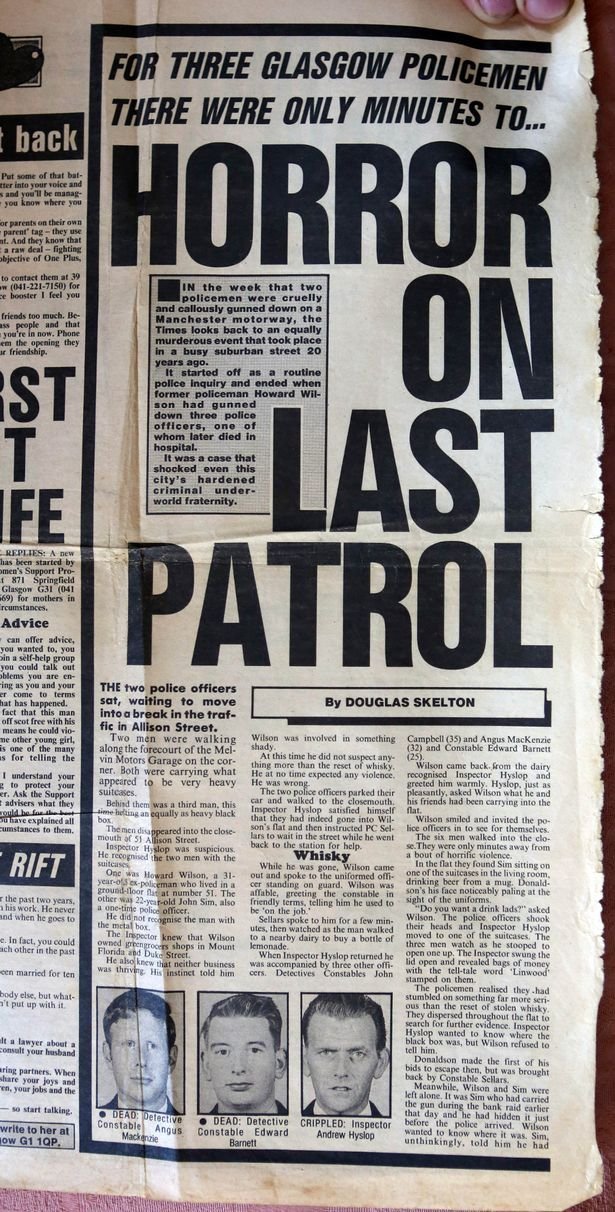

On December 30th 1969 two police officers died of bullet wounds during a raid on a house in Allison Street, Glasgow; a third was wounded.
Police in Glasgow still remember the murder of two officers, when one of their ex colleagues was spotted with a suspicious package after robbing a bank in Linwood. The horrifying case was led by an ex police officer, who was in jail until 2002.
Shortly after 4pm two officers were shot dead by a man seen acting suspiciously outside a flat in Govanhill on the south side of the city. Their suspect had just taken part in an armed robbery and was carrying the proceeds into the Allison Street tenement in suitcases.
When the two cops followed their man into the ground floor apartment, unaware of the earlier hold-up, he pulled out a gun and shot them dead. The double murder was all the more shocking because it was carried out by a former police officer and colleagu
A few hours later Howard Wilson, married with a young family, was sitting in his police cell in nearby Craigie Street Police Office confessing both murders to his bewildered lawyer Joe Beltrami.
Nineteen years later in his memoir Tales of the Suspected, Beltrami wrote: “As I listened to him. I kept asking myself what could have possessed him.
“He looked more like a businessman than a criminal.”
Wilson had quit the City of Glasgow police in 1968 after 10 years’ service when he failed to get promotion to sergeant.
Instead he opened a greengrocers, The Orchard in nearby Mount Florida. But the outlet, along with another shop he’d bought, was losing money.
His two best friends former prison officer Ian Donaldson, 31, and ex-cop John Sim, 21, both had young families and were also strapped for cash. During one late evening drinking session they joked about robbing a bank to solve all their financial worries. However, the morning after the night before it began to sound like a plan.
Who would suspect two former cops and a prison officer? They had no criminal records and their fingerprints were not on file. The money would also be used to pay off debts so it would disappear as quickly as it had been stolen.
Thus the pieces of a jigsaw were put in place that would result in a cold blooded double execution almost six months later.
The trio recruited a fourth man – Archibald McGeachie – to be their getaway driver, and bought a Russian pistol from the president of the Bearsden Shooting Club, of which all three were members. On July 16, dressed in smart suits and carrying briefcases they walked into the British Linen Bank in Giffnock, East Renfrewshire, and escaped with £20,876 (£270,000 now).
All three, however, were broke again by Christmas and, having got away with it once, planned another heist – this time a branch of the Clydesdale in Linwood, Renfrewshire on December 30.
However, McGeachie took cold feet and declined the job of getaway driver, leaving his three pals to do the job on their own.
On December 23, a week before, the second hold up, he disappeared from his home and was never been seen again.
His fellow robbers escaped this time with £14,000 – much of it in silver coins – which later proved significant when they were all spotted by a suspicious Inspector Andrew Hyslop transporting the suitcases. He recognised Wilson who he had once trained in the use of firearms.
Inspector Hyslop also suspected the trio were carrying stolen whisky, as he didn’t know about the bank robbery. He confronted all three in Wilson’s ground floor flat, having called in reinforcements from Craigie Street.
When the inspector bent down to open one of the cases, his former colleague shot him in the face. Detective Constable Angus MacKenzie and PC Edward Barnett, were then both shot in the head when they tried to arrest him.
As they fell, Wilson calmly stepped up to DC MacKenzie and shot him again, killing him outright.
His accomplice Donaldson had fled the flat, while Sim watched in horror. Wilson turned his attention to another former colleague PC John Sellars, who had taken refuge in the bathroom to radio for help but he couldn’t get through the door. Wilson then noticed Inspector Hyslop beginning to move on the floor, and went to finish him off.
A fifth officer, Detective Constable John Campbell flung himself across the hall at Wilson before he could fire again, saving his colleagues’ life.
DC Campbell managed to wrestle the gun from Wilson just as his fellow officers alerted by the sound of gunfire rushed into the flat.
There they found a scene of unimaginable horror. DC MacKenzie had been killed outright while PC Barnett would die five days later in hospital.
Wilson only seemed to regret only what he had done to DC MacKenzie, whose wife June he knew personally. As he was led away, he asked the arresting officers if they would apologise to her on his behalf.
When the three appeared at Glasgow Sheriff Court on February 6, 1970, Wilson admitted the murders of Detective Constable McKenzie and Constable Barnett, attempting to murder Inspector Hyslop, threatening to shoot Constable Sellars, and to the bank robberies at Giffnock and Linwood. A week later, at the High Court in Edinburgh, Wilson was sentenced to life, with a recommendation that he should serve a minimum of 25 years. Donaldson and Sim were given 12 years each for their parts in the robberies.
Later that year it was announced that the Queen had approved awards of the George Medal to Inspector Hyslop and Detective Constable Campbell. Awards of the Queen’s Police Medal for Gallantry were posthumously awarded to Detective Constable McKenzie and Constable Barnett. In 1971, PC Sellars was awarded the Glasgow Corporation medal for bravery by the Lord Provost.
Detective Constable McKenzie left a widow, June, and Constable Barnett a widow, Margaret, and two children.
Of the three officers who survived, Inspector Hyslop suffered most as bullet parts had been left deeply embedded in his neck. After many months on sick leave Inspector Hyslop returned to duty. But the shock of his terrible experience had left him unfit to carry on and in June, 1971, he had to resign from the force and died on the island of Islay in 2000, aged 74.
In December 2009, on the 40th anniversary of the murders, Alastair organised a memorial service at Linn Crematorium in Castlemilk where the two officers are buried side by side, attended by their widows.
In September 2002, Wilson was finally freed after almost 33 years behind bars despite strenuous objections from the Scottish Police Federation.
At the time its chairman Norman Flowers, said: “We feel that anyone who murders a police officer should never be released. Life should mean life.”
More facts about this brutal crime can be found here http://www.policemuseum.org.uk/the-allison-street-police.../
7 notes
·
View notes
Text
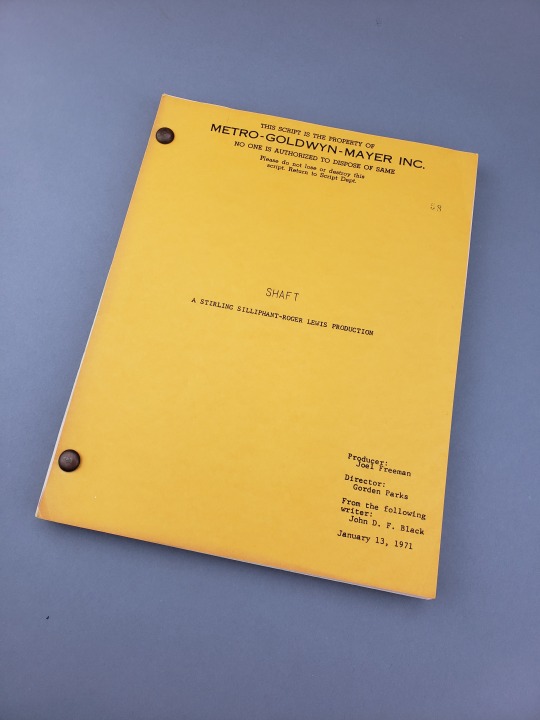
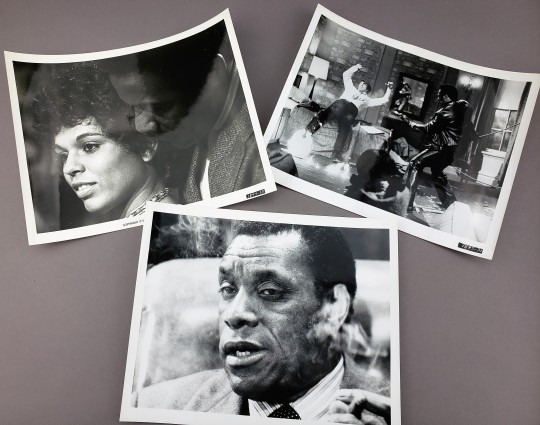
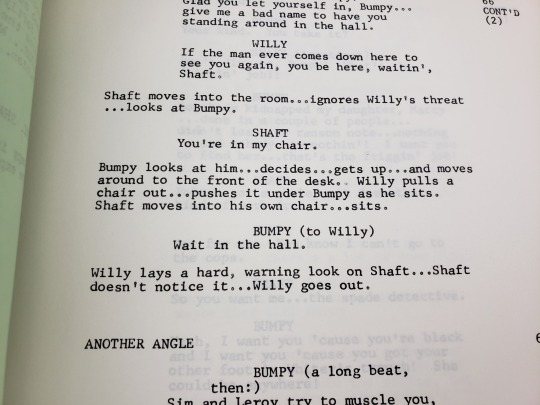
Shaft and the Era of Blaxploitation
Last year, Special Collections and Archives at the University of Iowa Libraries acquired items to form a new collection: the Black Film and Television Collection. In honor of Black History Month, we’re shining a spotlight on a different item from this collection each week.
In last week’s post, we discussed the lobby card for Oscar Micheaux’s 1938 film Swing, starring Cora Green. Our next spotlight is on original materials from the 1971 film Shaft, which includes the script used in the production in the movie, which was a defining entry in the Blaxploitation genre.
What is “Blaxploitation?”
We’ll start with the obvious: the word itself blends “Black” and “exploitation” and was coined by Beverly Hills-Hollywood NAACP president Junius Griffin in 1972 and wasn’t in the context of praise.
Blaxploitation movies are made by black filmmakers with black actors for black audiences. They portray strong black characters who were the heroes and leads. During the mid- to early 1970s, more than 200 movies of the genre were made, in subgenres such as horror, westerns, comedy, drama, and action.
Rather than trying to dispel stereotypes, movies like Shaft reinforce them. And while the movies were popular with audiences, that approach did create some critics, like Junius Griffin and other NAACP members.
Exploiting a lurid loophole
The Hays Code ruled Hollywood from 1934 to 1968, enforcing a strict set of moral standards for films. But filmmakers tend to be creative people, and “exploitation films” were the loophole they chose. If they depicted these offensive (and entertaining) subjects under the guise of a cautionary tale, they could get away with including them.
Over the years, court cases and boundary-breakers chipped away at the Hays Code. In 1968—the same year most history textbooks mark as the end of the Civil Rights Movement because it coincides with the assassination of Dr. Martin Luther King, Jr.—the Motion Picture Association of America (MPAA) scrapped the Code in favor of the film rating system. It was into these unique circumstances that a new genre—Blaxploitation—was born.
John Shaft’s world
Shaft is an adaptation of Ernest Tidyman’s 1970 detective novel, directed by Gordon Parks. Opening on an urban panorama overlaid with a funk soundtrack, the movie stars Richard Roundtree as John Shaft, a stylish and suave private detective in New York who is approached by the boss of a Harlem organized crime family (Moses Gunn) in search of his kidnapped daughter (Sherri Brewer). In the course of his mission, Shaft dispatches mafiosos, teams up with activists in the Black Power Movement, and delivers enough one-liners to cement his legacy as one of the iconic characters of 20th century film.
Even a brief glimpse at the original movie script’s pages (like the one shown above) showcase the swagger and bombast of the protagonist, who would go on to anchor multiple sequels. The movie’s iconic theme song, written and recorded by Isaac Hayes, has been sampled and reused dozens of times since the movie’s release, and the film itself has been preserved by the Library of Congress. It provides one of the early blueprints for the Blaxploitation genre, which continued to flourish throughout the 1970s.
It’s well worth noting that while Shaft’s director, stars, and core audience were Black, its writers were both white men. This information certainly complicates how many viewers receive the film’s representation of Black characters—and those complications became the focus of blaxploitation’s most vocal detractors.
Blaxploitation may have had its heyday in the 1970s, but it’s never truly ended. The genre was carried into the 21st century by the generation of filmmakers it inspired, including John Singleton, Spike Lee, and the Hughes Brothers.
Our next entry will be a look at Cheryl Dunye’s 1997 film The Watermelon Woman, and the growing influence of Black women in the film industry.
---Natalee Dawson, Communication Coordinator at UIowa Libraries with assistance from Anne Bassett, Liz Riordan, and Jerome Kirby
25 notes
·
View notes
Text

"True emancipation lies in the acceptance of the whole past in deriving strength from all of my roots, in facing up to the degradation as well as the dignity of my ancestors."
As we come to the end of Pride Month 2023, I wanted to devote a little time to the remarkable life of Rev. Anna Pauline "Pauli" Murray --civil rights attorney, Episcopal priest, scholar, and advocate. Born in 1910 Baltimore, their mother tragically died when Murray was only four, and their father succumbed to depression and was later murdered in a mental hospital, and so Murray was raised by an aunt and grandparents, in a time when the threat of violence from the Ku Klux Klan was never too far away. Murray later moved to New York City and graduated from Hunter College in 1933 (as Columbia College did not at the time admit women). Throughout the 1930's Murray grappled with sexual and gender identity --this is in fact when they took on the preferred male-identifying name of "Pauli." A gifted photographer but an even more prolific author, Murray worked as a teacher with the New York City Remedial Reading Project, which offered a great deal of opportunity to write and publish. Among other publications, Pauli's essays and articles about civil rights would regularly appear in The Crisis and in Common Sense (both publications of the NAACP).
Pauli took the unusual (and risky!) step of petitioning to apply to graduate school at the University of North Carolina (current events alert!) --at the time an all-white institution. Such a prospect was considered sufficiently unobtainable that even the NAACP declined to actively support this effort. Pauli had in the meantime cultivated the acquaintance of then-First Lady Eleanor Roosevelt, as well as A. Philip Randolph (see Lesson #68 in this series); associations which would later carry consequences. Pauli is listed as one of the founders of CORE (Congress of Racial Equality), along with Bayard Rustin (see Lesson #5 in this series), and James Farmer (Lesson #17). In 1943 they published a hugely important essay: "Negroes Are Fed Up;" and also a poem, Dark Testament, both of which spoke to the Harlem Race Riot of 1935.
In 1944 Murray graduated from Howard University Law School --while largely identifying as a man but still presenting as a woman, Murray famously coined the expression "Jane Crow" to describe the experience. They then applied to Harvard Law for an advanced degree on a Rosenwald Fellowship but was turned down --reportedly not due to racism (exact same current events alert!) but definitely due to sexism. They instead opted for the University of California Boalt School of Law; their graduate thesis was titled "The Right to Equal Opportunity in Employment." In 1945 Murray was named deputy attorney general for the state of California; the first African American to hold that post. In 1951 Pauli published States' Laws On Race and Color, a book that would later be described by Thurgood Marshall as the "Bible" for civil rights litigation, and was conspicuously referenced during Brown v. Board of Education arguments.
In 1952 the scourge of McCarthyism caught up with Murray and cost them a number of prestigious posts due to affiliation with "radicals" like Marshall, Randolph, and particularly Ms. Roosevelt. Unbowed, Pauli went on to publish the gripping biographical account Proud Shoes, which led in turn to a job offer in the litigation dept. of Paul, Weiss, Rifkin, Wharton, and Garrison (as in, Lloyd), where she would meet lifelong partner Irene Barlow. In 1960 Pauli was appointed by President John F. Kennedy to the Committee on Civil And Political Rights, but the issue of intersectionality was never far from their priorities; notably in 1963 Murray took Bayard Rustin, A. Philip Randolph, and Martin Luther King to task for not including a single woman speaker at the March On Washington. Perhaps the most fascinating coda to this remarkable life comes in 1977, when in the wake of Irene Barlow's passing, Murray became the very first African-American woman Episcopal priest. Pauli died in 1985, having never come out publicly.
For a comprehensive listing of Pauli's writings, visit the Pauli Murray Center for History and Social Justice: https://www.paulimurraycenter.com/paulis-writing
11 notes
·
View notes
Text
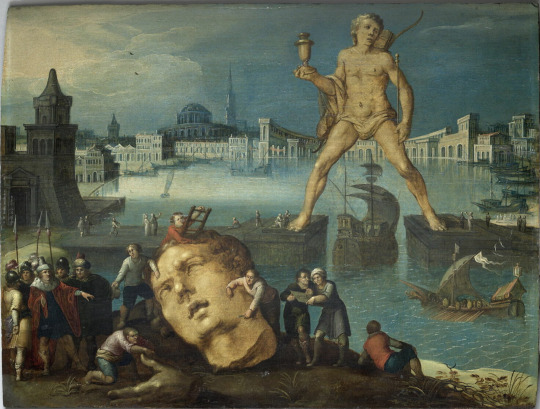
The Colossus of Rhodes
The Colossus of Rhodes was a statue of Helios, the Greek sun God, which stood over the Greek island city Rhodes. Notably known as one of the Seven Wonders of the Ancient World, the Colossus was erected by Chares of Lindos in c. 282 B.C.E. to celebrate the defeat of Demetrius I Poliorcetes, who had besieged the city for over a year.
Made of bronze, the statue was reported to stand at 70 cubits (105-110ft ; 32-33m) tall--about the same height as the Statue of Liberty, and acting as the tallest statue of the ancient world--and took almost twelve years to construct. Presiding over Mandrákion harbour, it is dated back to 1395 C.E. by the writings of an Italian who visited the island that the statue straddled the harbor (see painting above).
Tragically, around 227-225 B.C.E., an earthquake hit the island of Rhodes, snapping the Colossus at the knees. The collapsed statue was left untouched until 653-654 C.E. when *supposedly* Arabian forces, acting under Mu'awiya I, raided Rhodes. Pieces were said to be sold, totaling more than 900 camel loads.

Reconstruction
Ptolemy III offered to help pay towards the reconstruction of this statue, but the Oracle of Delphi made the people of Rhodes believe that Helios was offended, thus the offer met refusal.
Another reason for reconstruction being refused is due to the seismically unstable location Rhodes found itself belonging to. Having multiple devastating earthquakes cemented the unlikeliness that the statue could withstand existing if built again.
Misconception
The misconception towards the Colossus's stance, particularly from medieval interpretations, was disputed by simple explanations in John Lemprière's Bibliotheca Classica (Classical Dictionary). Lemprière states that construction would have blocked the harbor, and when the statue was finally built, builders would've needed to clean everything from the harbor in order to reopen. Additionally presented, when the Colossus met its dismay, it would have blocked the harbor and been left unseen on land (which we know isn't true considering many stories of Rhodes being a tourist destination just to see the fragments of Helios left scattered).
Furthermore, if you apply physics, you'd understand that the weight met with its legs-wide stance would crumple on its own.
The statue of Rhode's patron God is unknown by appearance besides that it may have curly hair and halo of spiked flame due to engravings on Rhodian coins which pictured Helios. The Colossus's pose is disputed, though historians believe Helios hovering his arm near his eyes to block light, attributing this possibility to a nearby temple's relief which shows the God performing the aforementioned action.

Credits
Beginning Piece:
"Le colosse de Rhodes"
by Louis de Caullery
Oil on Panel Painting, before 1622.
Louvre Museum.
Last Piece:
"Colosse de Rhodes"
by Sidney Barclay
Engraving, circa 1875.
Sources Used:
Art In Context
Britannica
Wikipedia (hey, they have good sources listed, I could've lied about what I read and put all of those here instead).
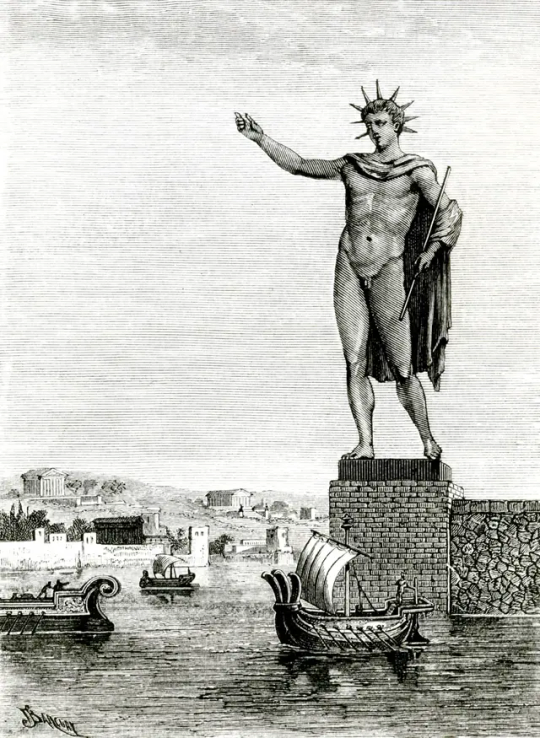
#seven wonders#seven wonders of the ancient world#ancient greece#ancient#colossus of rhodes#statue#scultpure#history#art history#painting#art#greece#rhodes#greek history#greek gods#helios
6 notes
·
View notes